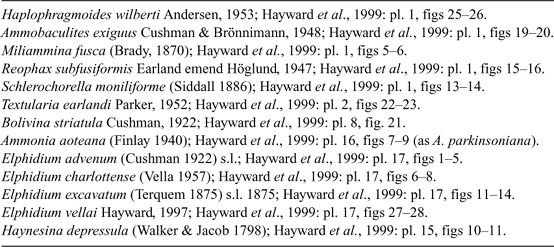Foraminiferal record of ecological impact of deforestation and oyster farms, Mahurangi Harbour, New Zealand
Hugh R. Grenfell A C , Bruce W. Hayward A and Mark Horrocks BA Geomarine Research, 49 Swainston Rd, St Johns, Auckland 1072, New Zealand.
B Microfossil Research, 31 Mont Le Grand Rd, Mt Eden, Auckland 1024, New Zealand.
C Corresponding author. Email: h.grenfell@geomarine.org.nz
Marine and Freshwater Research 58(5) 475-491 https://doi.org/10.1071/MF06155
Submitted: 31 August 2006 Accepted: 8 March 2007 Published: 22 May 2007
Abstract
The microfossils in eight short sediment cores in Mahurangi Harbour, northern New Zealand, record major ecological changes since colonisation by Europeans. During the period of catchment deforestation (1850s–1900) these changes include increased sedimentation rates, decline of soft-shore molluscs, increased diatoms and seaward migration of brackish, agglutinate-dominated, foraminiferal associations, inferred to be due to increased freshwater runoff and decreased pH. The interval of most rapid change (1950s–1980s) occurred before and during the establishment of oyster farms, which therefore are not implicated. Comparison of the microfossil content of surface sediment samples taken inside and outside of four oyster farms indicates variable effects dependent on farm location. In less saline sites, the presence of oyster-shell debris in sediment beneath oyster farms appears to have buffered the foraminiferal faunas from some of the impacts of lowered salinity and pH. At more tidally flushed, saline sites, the oyster farms influence a wider surrounding area that has lower relative abundance of three species of Elphidium and other calcareous Foraminifera, attributed to slightly muddier sediment, higher nutrients and consequently lower oxygen. A newly arrived exotic foraminifer, Elphidium vellai, appears to be an indicator species for the enhanced nutrient, carbonate-rich conditions beneath oyster farms.
Additional keywords: benthic Foraminifera, freshwater runoff, pH, salinity.
Acknowledgements
We thank Shungo Kawagata for assistance in the field; Ashwaq Sabaa and Rhiannon Daymond-King for assistance in the laboratory and Barrie Forrest and Andrew Swales for critically reading the manuscript and suggesting improvements. This research was funded by the New Zealand Foundation for Research, Science and Technology.
Angel, D. L. , Verghese, S. , Lee, J. J. , Saleh, A. M. , Zuber, D. , Lindell, D. , and Symons, A. (2000). Impact of a net cage fish farm on the distribution of benthic Foraminifera in the northern Gulf of Eilat (Aqaba, Red Sea). Journal of Foraminiferal Research 30, 54–65.
| Crossref | GoogleScholarGoogle Scholar |
Buzas, M. A. , Culver, S. J. , and Jorissen, F. J. (1993). A statistical evaluation of the microhabitats of living (stained) infaunal benthic foraminifera. Marine Micropaleontology 20, 311–320.
| Crossref | GoogleScholarGoogle Scholar |
Debenay, J.-P. (2000). Foraminifers of paralic tropical environments. Micropaleontology 46((Supplement 1)), 153–160.
| Crossref | GoogleScholarGoogle Scholar |
Forrest, B. M. , and Creese, R. C. (2006). Benthic impacts of intertidal oyster culture, with consideration of taxonomic sufficiency. Environmental Monitoring and Assessment 112, 159–176.
| Crossref | GoogleScholarGoogle Scholar | PubMed |
Hayward, B. W. , and Hollis, C. J. (1994). Brackish Foraminifera in New Zealand: a taxonomic and ecologic review. Micropaleontology 40, 185–222.
| Crossref | GoogleScholarGoogle Scholar |
Hayward, B. W. , Scott, G. H. , Grenfell, H. R. , Carter, R. , and Lipps, J. H. (2004). Techniques for estimation of tidal elevation and confinement (~salinity) histories of sheltered harbours and estuaries using benthic Foraminifera: Examples from New Zealand. The Holocene 14, 218–232.
| Crossref | GoogleScholarGoogle Scholar |
Kaiser, M. J. , Laing, I. , Utting, D. , and Burnell, G. M. (1998). Environmental impacts of bivalve mariculture. Journal of Shellfish Research 17, 59–66.
Le Cadre, V. , Debenay, J.-P. , and Lesourd, M. (2003). Low pH effects on Ammonia beccarii test deformation: implications for using test deformations as a pollution indicator. Journal of Foraminiferal Research 33, 1–9.
| Crossref | GoogleScholarGoogle Scholar |
Morrisey, D. J. (1993). Environmental impact assessment – a review of its aims and recent developments. Marine Pollution Bulletin 26, 540–545.
| Crossref | GoogleScholarGoogle Scholar |
Murray, J. W. (2000). The enigma of the continued use of total assemblages in ecological studies of benthic foraminifera. Journal of Foraminiferal Research 30, 244–245.
| Crossref | GoogleScholarGoogle Scholar |
Orr, J. C. , Fabry, V. J. , Aumont, O. , Bopp, L. , Doney, S. C. , Felly, R. A. , Gnanadesikan, A. , Gruber, N. , Ishida, A. , and Joos, F. , et al. (2005). Anthropogenic ocean acidification over the twenty-first century and its impact on calcifying organisms. Nature 437, 681–686.
| Crossref | GoogleScholarGoogle Scholar | PubMed |
Wildish, D. J. , Hargrave, B. T. , and Pohle, G. (2001). Cost-effective monitoring of organic enrichment resulting from salmon mariculture. ICES Journal of Marine Science 58, 469–476.
| Crossref | GoogleScholarGoogle Scholar |


|


